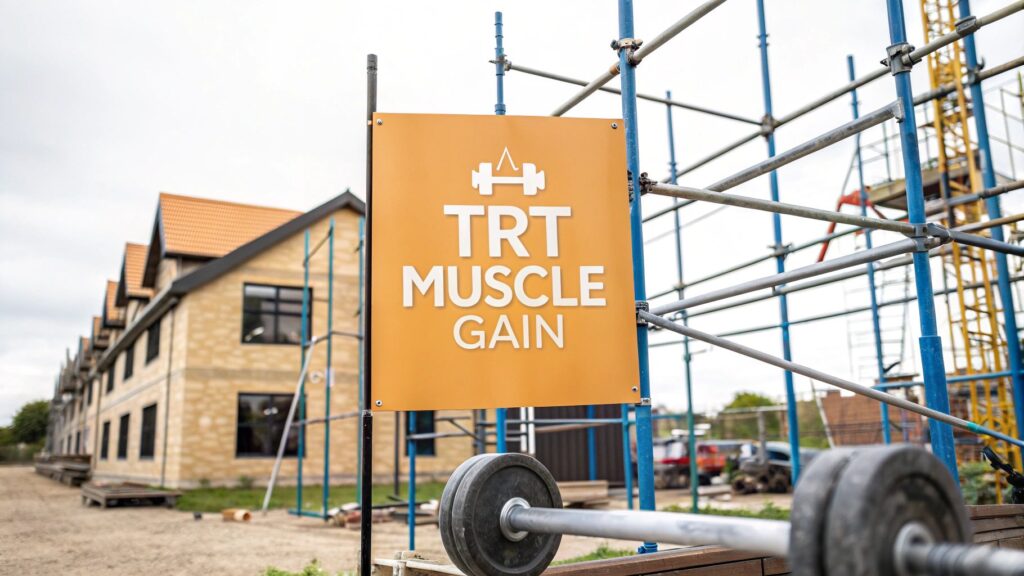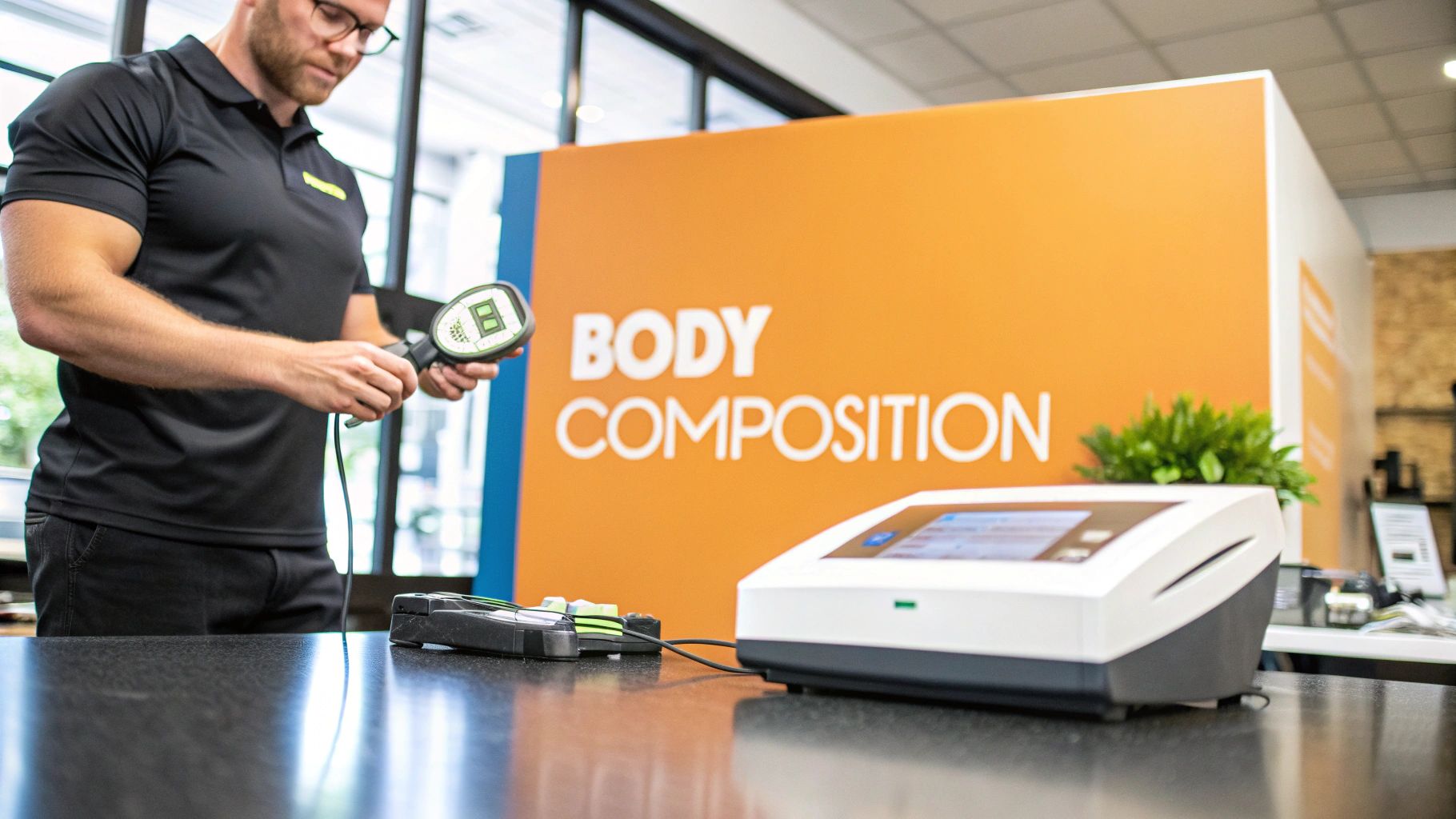Testosterone Replacement Therapy (TRT) is a game-changer for muscle gain because it restores your body's most powerful anabolic hormone to its optimal state. It’s like flipping a switch that turns on muscle protein synthesis, the core process of repairing and building new muscle fibers after you train. By correcting low testosterone, TRT creates the perfect internal environment for growth, making it far easier to pack on lean mass.
How TRT Kicks Muscle Growth Into High Gear
Picture a construction site that’s been sitting quiet for years. The blueprints are there, the crew is ready to go, but the project manager with the authority to get things started is nowhere to be found. In this scenario, your muscles are the construction site, and testosterone is that crucial project manager. When levels are low, nothing gets built efficiently.
TRT is like bringing that manager back on-site and giving them the green light. All of a sudden, the entire operation roars to life. Materials get delivered, the crew gets to work, and construction begins. That's exactly what happens inside your body—optimizing your testosterone levels reawakens your muscle-building machinery.
The Anabolic Catalyst Effect
TRT doesn't just create muscle out of thin air. Instead, it fosters the ideal anabolic (muscle-building) state where all your hard work in the gym and dedication in the kitchen finally pay off with much bigger results.
Here’s a look at the key mechanisms TRT sets in motion to support trt muscle gain:
| Key Mechanisms for TRT Muscle Gain |
|---|
| A quick overview of how testosterone directly and indirectly supports muscle growth. |
| Mechanism | Simplified Explanation | Primary Outcome |
|---|---|---|
| Enhanced Protein Synthesis | Tells your muscle cells to build new proteins faster than old ones are broken down. | Net muscle gain and faster repair. |
| Increased Nitrogen Retention | Helps your muscles hold onto more nitrogen, a key component of protein. | Keeps your body in an anabolic state. |
| Improved Recovery | Shortens the time needed to recover between workouts. | Allows for more frequent, intense training. |
These mechanisms work together to create an environment where your body is primed to build and maintain lean tissue, effectively reversing the catabolic (muscle-wasting) state that often comes with hormonal decline.
This infographic breaks down the direct path from starting TRT to seeing real muscle growth.

As you can see, TRT acts as the trigger. It directly boosts your testosterone, which in turn unlocks the door to significant muscle development that was previously out of reach.
Backed By Clinical Evidence
This isn't just theory; it's a physiological response that's been documented time and again. A landmark study from 1997 showed that men with low testosterone saw substantial increases in both fat-free mass and muscle size in just 10 weeks of therapy.
On average, the men in the study gained 4.5 kg (nearly 10 pounds) of body weight, almost all of it from lean tissue. This highlights just how effective TRT is at reversing muscle loss and promoting new growth.
Ultimately, TRT provides a powerful foundation, but your dedication to training and nutrition is the engine that drives your results forward. To learn more about what this therapy can do for your overall health and vitality, check out our detailed guide on the benefits of TRT.
The Science of Testosterone and Muscle Building

To really get why TRT muscle gain is so effective, we have to look past the weights and into the biology humming away inside your muscle cells. Testosterone is the master architect of male physiology, and its command over muscle tissue is direct, powerful, and works on multiple fronts. It operates at the cellular level, kicking off a chain of events that turns the potential for growth into real, hard muscle.
Think of each muscle cell as a high-security building with a specific lock on its door. These locks are called androgen receptors. Testosterone molecules are the perfectly cut keys for these locks. When you bring your testosterone levels into the optimal range with TRT, you’re essentially flooding your system with more keys, making sure every single available lock gets turned.
This "unlocking" sends a powerful signal straight to the cell's nucleus—its command center. The main order it sends out? To crank up muscle protein synthesis, which is the core process of repairing muscle fibers you’ve broken down in the gym and building them back bigger and stronger.
The Anabolic Signaling Cascade
Once testosterone binds to that androgen receptor, it does a lot more than just flick the "on" switch for protein synthesis. It sets off a powerful chain reaction, amplifying your body's muscle-building machinery in several ways. This isn't just about telling a muscle to grow; it's like testosterone is the general contractor orchestrating the entire construction project from the ground up.
This cascade brings several key players into harmony:
- Direct Gene Activation: Testosterone directly flips the genetic switches responsible for muscle growth into a higher gear.
- Growth Factor Amplification: It ramps up the production of other powerful anabolic hormones, most notably Insulin-like Growth Factor 1 (IGF-1).
- Satellite Cell Mobilization: It wakes up dormant muscle stem cells, calling in the reinforcements needed to repair and expand your muscle fibers.
These actions all work together, creating a powerful synergy. You’re not just building muscle faster; you’re actually improving the very systems that support and maintain that growth for the long haul.
Awakening Your Muscle Stem Cells
Maybe one of the most critical parts of achieving significant TRT muscle gain is the activation of satellite cells. These are basically muscle stem cells that hang out on the outside of your muscle fibers, just waiting for the signal to get to work. A tough workout provides the initial spark, but testosterone is the megaphone that shouts the order and mobilizes them in droves.
Once activated, these satellite cells multiply and then fuse with your existing muscle fibers. This process, called myonuclear donation, does two incredible things. First, it patches up the microscopic damage your workouts create. Second, it adds new nuclei to the muscle cells, which permanently increases their potential for future growth and strength.
By increasing the number of myonuclei within a muscle fiber, testosterone doesn't just help the muscle grow larger now—it expands its fundamental capacity for size and strength down the road.
This is a big reason why the muscle you gain on TRT, when paired with smart training, feels so dense and solid. You aren't just temporarily pumping up the muscle; you're fundamentally re-engineering it to be bigger and stronger at its very core.
Amplifying Anabolic Hormones like IGF-1
Testosterone doesn't operate in a vacuum. A huge part of its muscle-building power comes from its ability to boost other key growth factors, and Insulin-like Growth Factor 1 (IGF-1) is a major player. IGF-1 is another potent anabolic hormone that directly drives muscle protein synthesis and repair.
Think of it like this: testosterone is the general manager who gives the overall command to build, while IGF-1 is the on-site foreman who carries out those orders with precision. By raising testosterone with TRT, you make sure that both the high-level strategy and the boots-on-the-ground execution are perfectly synced up for maximum growth.
This hormonal teamwork makes your body incredibly efficient at using the protein you eat and the stimulus you create at the gym. Every rep you lift and every meal you consume has a bigger impact, leading to steadier, more noticeable progress over time. This is the science that makes TRT such a powerful tool for transforming your physique.
How Much Muscle Can You Realistically Expect to Gain?
This is the big question, isn't it? When it comes to Testosterone Replacement Therapy, guys want to know how much muscle they can actually build. It’s absolutely critical to draw a line in the sand between medically supervised TRT and the insane transformations you see from high-dose, illegal steroid cycles. TRT is a medical treatment. Its goal is to bring your hormone levels back into a healthy, optimal range—not to blast them into another stratosphere.
With that clear, the potential for serious TRT muscle gain is still incredibly impressive, especially if you’re starting with genuinely low testosterone. The therapy essentially turns back on the anabolic machinery your body has been missing, making every ounce of effort in the gym and the kitchen count for more. Think of it as finally being handed the right tools for a job you've been struggling with for years.
But you have to play the long game. You’ll probably feel stronger, more energetic, and notice you’re recovering faster within the first few weeks. That’s the engine warming up. Visible changes to your physique, however, take time. Real, noticeable gains in lean muscle mass generally take 3 to 6 months to show up in the mirror. From there, the gains continue to stack up, with most men seeing their biggest changes within that first year of consistent therapy.
The Timeline for Tangible Results
Understanding the pace of progress is key to setting goals that don’t leave you frustrated. Your body needs time to adapt to its new hormonal environment and get to work building new tissue. Everyone’s journey is a bit different, but a general timeline can give you a solid idea of what to expect. For a much deeper dive, our detailed guide on the TRT results timeline gives a comprehensive week-by-week breakdown.
So, what does the science say? An analysis of several high-quality studies found that men on TRT for over three months gained an average of 1.5 to 3.5 kilograms (that’s about 3.3 to 7.7 pounds) of lean body mass. The kicker? This muscle gain happened even in guys who didn't change their exercise habits, which just shows how powerful testosterone is on its own. Of course, when you combine TRT with resistance training, you unlock a synergy that blows either one out of the water. You can find more details on these muscle gain findings on TRTED.org.
TRT Alone Versus TRT with Training
It’s crucial to see TRT for what it is: a powerful catalyst, not a magic pill. It creates the potential for muscle growth, but hitting the weights provides the stimulus needed to cash in on that potential.
Let's break down the two scenarios:
- TRT Without Training: A guy on TRT who stays on the couch will still likely see some positive changes. He might drop a bit of body fat and gain a few pounds of lean mass over several months as his body's metabolic engine gets a tune-up. This is the baseline effect of just having optimal hormone levels.
- TRT With Consistent Training: This is where the real magic happens. When you pair optimized testosterone with a solid weightlifting program, the results multiply. Your ability to recover between workouts skyrockets, letting you train harder and more often. The muscle-building signals fired off by TRT go into overdrive, using the stimulus from your lifts to forge new muscle at a much faster rate.
The difference is night and day. While TRT alone might add a few pounds of muscle, TRT combined with dedicated training can lead to substantial, physique-altering gains of 10, 15, or even 20+ pounds of lean mass over the first year, depending on your genetics, diet, and how consistent you are.
Ultimately, TRT opens a door to muscle growth that was previously locked shut. By pairing it with consistent training and smart nutrition, you’re not just walking through that door—you’re sprinting. This one-two punch is what allows you to build a stronger, leaner, and more resilient body.
Optimizing Your TRT Protocol for Mass

Getting impressive trt muscle gain isn't just about taking testosterone. It’s about the precision of your medically supervised protocol. Think of your TRT plan as the blueprint for your body's entire hormonal environment. A generic, one-size-fits-all plan might get you into a healthy range, but a fine-tuned protocol is what builds the high-performance machine you’re actually aiming for.
The real goal is hormonal stability. Your body thrives on consistency, and wild swings between high and low testosterone levels will stall your progress and open the door to unwanted side effects. The right protocol, developed with your doctor, ensures your system has a steady supply of this crucial hormone, keeping your muscle-building engines running at full capacity, 24/7.
Choosing the Right Delivery Method
How testosterone gets into your body plays a huge role in achieving that coveted stability. Each method has its own unique profile for release, absorption, and daily impact on your hormone levels. This makes working with a physician to choose the best one for your goals and lifestyle a critical first step.
Here’s a breakdown of the most common options and what they mean for building muscle:
- Intramuscular Injections: Long considered the gold standard for trt muscle gain, injections allow for precise dosing and predictable absorption. More frequent, smaller injections (like twice a week) are often preferred over one large weekly dose. This approach better mimics the body's natural rhythm and maintains stable blood levels, preventing the dreaded peaks and troughs.
- Topical Gels or Creams: While convenient, gels can lead to more daily fluctuation in testosterone levels. They also carry a risk of transference to others through skin contact. For some, they provide a steady-enough baseline, but they're often less than ideal for those seeking maximum anabolic stability.
- Subcutaneous Injections: This is a newer method involving smaller needles injected into fat tissue. It can offer a slow, steady release similar to more frequent intramuscular shots but with much greater comfort for many guys.
Studies consistently show that intramuscular TRT often leads to greater increases in fat-free mass, and this is likely due to the highly stable and optimized hormone levels it can provide. That consistency is what keeps protein synthesis elevated around the clock.
To make this clearer, let's compare these methods head-to-head.
Comparing TRT Administration Methods for Muscle Gain
The way you administer testosterone directly impacts hormone stability, which is a key driver for consistent muscle growth. This table breaks down the pros and cons of the most common delivery systems specifically for their muscle-building potential.
| Method | Hormone Stability | Pros for Muscle Gain | Cons to Consider |
|---|---|---|---|
| Intramuscular Injections | High (especially with frequent dosing) | Allows for precise, stable blood levels, maximizing the anabolic environment. Considered the most effective for consistent growth. | Requires learning self-injection; potential for scar tissue with long-term use. |
| Subcutaneous Injections | High | Provides a slow, steady release similar to frequent IM shots but with smaller, less intimidating needles. Excellent stability. | May not be suitable for larger injection volumes; some may experience localized skin reactions. |
| Topical Gels/Creams | Moderate to Low | Very easy and painless to apply daily. | Can cause significant daily hormone fluctuations; risk of transferring to partners or children; absorption can be inconsistent. |
Ultimately, injections—whether intramuscular or subcutaneous—tend to offer the superior hormonal control needed to maximize your body's muscle-building machinery.
The Critical Role of Dosage and Timing
Once you and your doctor lock in a delivery method, the next levers to pull are dosage and timing. And this is definitely not a "more is better" game. The whole point of TRT is to restore your levels to the high end of the normal, healthy range—not to push them into supraphysiological territory.
Your ideal dose is the minimum amount required to eliminate low-T symptoms and put your blood levels in the optimal zone for muscle growth and well-being, all while keeping your other health markers in check.
This is where regular blood work becomes non-negotiable. Your physician will monitor your total and free testosterone levels to make sure your dose is hitting the mark. Timing is just as important. For injections, splitting a weekly dose into two or even three smaller injections maintains much more stable levels, which is absolutely key for sustained muscle building.
Managing Estrogen for Maximum Anabolic Drive
Here’s a detail that many guys overlook: as testosterone increases, some of it naturally converts into estrogen (specifically, estradiol) through a process called aromatization. Estrogen is essential for male health—it supports joint health, libido, and cognitive function—but if your levels get too high, it can completely sabotage your muscle-building efforts.
Elevated estrogen can lead to:
- Water retention and bloating, masking your hard-earned muscle definition.
- Increased body fat storage.
- Mood swings and fatigue.
- The development of gynecomastia (male breast tissue).
Balancing your testosterone-to-estrogen ratio is crucial for maximizing your trt muscle gain. Your doctor will monitor your estradiol levels through blood work. If they climb too high, a carefully dosed aromatase inhibitor (AI) might be prescribed to control the conversion process. The key here is balance, not elimination. Crashing your estrogen is just as bad as letting it run wild. By fine-tuning this hormonal interplay, you ensure your body stays in a powerful anabolic state, primed for growth and free from nasty side effects.
Fueling Your Gains with Smart Training and Nutrition
Think of Testosterone Replacement Therapy as upgrading your car’s engine from a standard four-cylinder to a high-performance V8. Suddenly, you have incredible power under the hood. But that power is useless until you actually press the accelerator and give it the right fuel.
In this case, smart training is the accelerator, and targeted nutrition is the high-octane fuel. TRT provides the opportunity, but what you do in the gym and the kitchen is what actually builds the muscle. Without them, you’re leaving the most significant potential for TRT muscle gain sitting in the garage.
The synergy here is what matters. By optimizing your testosterone, your body’s ability to recover from intense training is dramatically improved. This lets you train with more volume and intensity without hitting that familiar wall of overtraining, leading to faster, more consistent progress.
Build Your Foundation with Resistance Training
To get the most out of TRT, your training has to send a clear signal to your muscles to grow. TRT amplifies your body's response to that signal, but it can't create the signal itself. This is why a well-structured resistance training program is non-negotiable.
Your primary focus should be on big, compound movements that recruit multiple muscle groups at once. These are the exercises that trigger a larger hormonal response and build functional strength that translates into a powerful physique.
A classic, effective split might look something like this:
- Push Day: Focus on chest, shoulders, and triceps (e.g., Bench Press, Overhead Press, Dips).
- Pull Day: Target your back and biceps (e.g., Deadlifts, Pull-Ups, Barbell Rows).
- Leg Day: Build a strong lower body (e.g., Squats, Leg Press, Romanian Deadlifts).
This structure ensures you hit every major muscle group with enough intensity and volume while giving you plenty of time to recover—a process that TRT will supercharge.
Fueling the Machine with a High-Protein Diet
With your body now in a prime anabolic state, its demand for raw materials goes through the roof. Protein is literally the building block of muscle tissue, so your intake needs to match your body's enhanced ability to synthesize it. Forgetting to increase your protein is like trying to build a brick house without ordering enough bricks.
On TRT, your body's muscle-building signals are firing constantly. To capitalize on this, you must provide a steady stream of amino acids through a high-protein diet, or the signals will go to waste.
Aim for 1.6 to 2.2 grams of protein per kilogram of body weight (or about 0.7 to 1.0 grams per pound). This gives your muscles all the fuel they need to repair and grow bigger and stronger after every workout.
Just as important is your total calorie intake. You simply can't build new tissue out of thin air. A modest caloric surplus—eating slightly more calories than you burn—is essential to provide the energy needed to construct new muscle. A surplus of 300-500 calories above your maintenance level is a great place to start.
This elevated testosterone environment makes your body incredibly efficient at packing on lean mass. Recent research confirms a strong positive link between serum testosterone and muscle mass, showing that men with higher levels had a 60% lower chance of having low muscle mass. This underscores that testosterone is a key player in building muscle quantity, even if it doesn't directly correlate with measures like grip strength. You can explore the full study about testosterone's impact on muscle mass to see the data for yourself.
Prioritizing Health and Safety on TRT

While the goal of impressive TRT muscle gain is exciting, it has to take a backseat to your long-term health. Let’s be clear: responsible Testosterone Replacement Therapy isn't a reckless pursuit of mass. It’s a precise medical intervention that demands respect, diligence, and professional oversight.
Think of it as a partnership between you and a qualified physician. You’re committing to regular monitoring and gaining a real understanding of your body’s internal chemistry. The objective isn't to push your hormones into dangerous territory, but to keep them in an optimal, healthy range. This proactive approach is what makes your success both significant and sustainable for years to come.
Navigating Potential Side Effects
Like any effective medical treatment, TRT can have side effects if it’s not managed correctly. A knowledgeable doctor knows what to look for and uses regular blood work to stay one step ahead, making minor tweaks to your protocol to keep you safe and feeling your best.
Three of the most important areas to keep an eye on include:
- Red Blood Cell Count (Hematocrit): Testosterone can stimulate red blood cell production. If this level, known as hematocrit, gets too high, it can thicken your blood and increase the risk of clotting.
- Cholesterol Levels: TRT can sometimes affect lipid profiles. Regular checks make sure your HDL ("good") and LDL ("bad") cholesterol stay in a healthy balance.
- Prostate Health (PSA): For men, especially those over 40, monitoring the Prostate-Specific Antigen (PSA) is a standard part of responsible TRT to screen for any changes.
Managing these markers is usually straightforward with simple adjustments to your dosage or injection frequency, all guided by what your lab results are telling us.
The Non-Negotiable Role of Blood Work
Blood work is the dashboard for your health while on TRT. It’s not just about checking testosterone levels; it's about seeing the full picture of how your body is responding to the therapy. This is the objective data your doctor needs to ensure your protocol is working perfectly for you.
Regular blood tests are your single most important tool for ensuring safety and efficacy. They transform TRT from guesswork into a precise, data-driven science, allowing for a protocol that is truly personalized to your body's needs.
Key biomarkers we consistently track include:
| Biomarker Monitored | Why It's Important |
|---|---|
| Total & Free Testosterone | Confirms your dosage is hitting the target hormone levels for optimal results. |
| Estradiol (E2) | Ensures your estrogen is balanced with testosterone to maximize gains and avoid side effects like water retention. |
| Hematocrit (HCT) | Monitors red blood cell concentration to prevent your blood from becoming too thick. |
| Complete Blood Count (CBC) | Provides a comprehensive overview of your blood health, including red and white blood cells. |
| Lipid Panel | Tracks cholesterol levels to protect your cardiovascular health. |
| PSA (Prostate-Specific Antigen) | Screens for any changes in prostate health, a crucial check-in for male patients. |
This systematic approach is fundamental to a safe and successful experience. For a deeper dive into this process, you can learn more about why TRT monitoring is so important in our guide.
Ultimately, working closely with a physician and staying on top of your lab work is what separates responsible therapy from risky behavior, ensuring your health always remains the top priority.
Common Questions About TRT and Muscle Gain
When you're considering TRT, a lot of practical questions come to mind. Let's cut through the noise and get straight to the answers you're looking for about TRT and building a stronger physique.
How Long Until I See Muscle Gain From TRT?
Patience is key here, but the results are worth the wait. While you'll probably feel a welcome kick in energy and strength within a few weeks, noticeable changes in muscle mass usually start showing up after 3 to 6 months of consistent, medically supervised therapy.
The most significant gains in lean body mass tend to happen within that first year. Just remember, results are highly individual. You'll massively speed up the process by pairing your TRT protocol with serious resistance training and a high-protein diet.
Will TRT Increase My Strength as Much as My Size?
Not always, and not in direct proportion. Testosterone is an absolute powerhouse for building muscle mass (hypertrophy), but its direct link to pure, raw strength is a bit less straightforward. You will absolutely get stronger as you build more muscle, but the therapy's main job is to increase the amount of lean tissue you have.
Think of it like this: TRT gives your body the green light and the raw materials to build a bigger engine. Your training program is what teaches that engine how to generate maximum force. Your strength gains are driven by the work you put in at the gym; TRT just creates the perfect environment for that hard work to pay off with better recovery and growth.
Research has confirmed that while testosterone levels are strongly tied to increased muscle mass, the connection to pure strength metrics, like grip strength, isn't as direct. This really highlights the synergy needed between your therapy and your training.
Can I Stop TRT After Gaining the Muscle I Want?
This is a big one. TRT is a medical treatment for a chronic condition like hypogonadism, which makes it a lifelong commitment for most men—not a temporary supplement cycle. If you stop therapy, your body's own testosterone production, which was shut down during treatment, likely won't just bounce back to normal.
That means your testosterone levels will plummet. As a result, you will almost certainly lose the hard-earned muscle you gained, and the original symptoms that brought you here—fatigue, low libido, and brain fog—will come roaring back. Any decision to change or stop your protocol has to be made under the strict guidance of your doctor to manage these outcomes safely.
Ready to explore how a personalized TRT plan can help you achieve your health and fitness goals? The experts at Elite Bioscience are here to guide you with safe, effective, and medically supervised therapies.
Start your confidential health assessment today with Elite Bioscience







